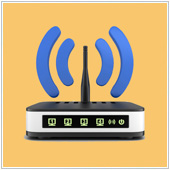 It’s normal to expect your mobile device’s internet browser to be lightning-fast. When it’s not, you might automatically think it’s because you haven’t updated your device’s OS or the browser app. In lots of cases, however, it’s due to slow mobile internet speed. Find out the most common causes for sluggish internet connection on your mobile device.
It’s normal to expect your mobile device’s internet browser to be lightning-fast. When it’s not, you might automatically think it’s because you haven’t updated your device’s OS or the browser app. In lots of cases, however, it’s due to slow mobile internet speed. Find out the most common causes for sluggish internet connection on your mobile device.
Wi-Fi noise
Did you know that home electronic appliances emit wireless signals at a frequency similar to your router’s (2.4 GHz)? So when deciding where to place your router, determine whether there are any electronic devices nearby, as they emit signals that can interfere with your router’s signal. For example, even if the ideal location for your router is in the middle of your house, you shouldn’t place it there if a cordless phone is nearby.
You can also set your router on a 5 GHz band, as this frequency is less prone to interference from other appliances. But before you start tuning it, make sure your phone supports 5 GHz; otherwise, it won’t be able to connect to the router.
Router location
One simple yet overlooked reason why your Wi-Fi-connected phone may be experiencing internet lag is because of your router’s location. Although Wi-Fi has a range of up to 230 feet, the signal gets weaker the farther you are from the router. Large objects like doors and walls situated in between your phone and the router can also weaken the transmission.
It’s recommended to place your router in a centralized location, preferably away from concrete and masonry walls or other big objects like a chimney. As the router signal radiates from all sides, blocking any side with big objects will impact your Wi-Fi’s signal quality, and consequently impede your phone’s internet speed.
Slow network
Another reason for your phone’s slow internet connection could be fluctuating network speeds. Ask yourself these two questions to discover the cause of this problem:
- How many devices are connected to the router?
- What are these devices using the internet for?
You should increase your router’s internet bandwidth speed if you discover you have many users and all of them are either streaming movies or downloading computer games or software updates. This will allow every phone connected to your network to enjoy faster internet speeds.
If you’re outdoors and connected to a public Wi-Fi network, consider using your mobile data instead. You won’t have to share your internet when you use mobile data, enabling you to experience faster connectivity at all times as long as you have a high-speed data plan.
Too much cache
Last, check your smartphone’s cache if fixing your router, network, and positioning doesn’t improve your device’s internet speed. Your phone’s cache saves data from earlier searches in order to display faster results of similar searches in the future. Although your phone becomes more efficient for that particular search, it also makes your phone much slower when you do other things that require the internet.
You can clear out your cache manually or use a cache cleaner app to get rid of useless cache and optimize your phone’s internet speed. If you decide to download a cache cleaner app, make sure that it is trustworthy so you don’t accidentally download a malware-infected program.
There are more reasons for your phone’s lagging internet speed. If your business relies heavily on a speedy mobile internet connection and you’re unable to fix the problem, call our experts today. We’re always ready to help you.

 As businesses have become more reliant on technology, they’ve also become a prime target of cybercriminals. If you want to protect your organization from cyberattacks, make sure your cybersecurity system doesn’t have the following flaws.
As businesses have become more reliant on technology, they’ve also become a prime target of cybercriminals. If you want to protect your organization from cyberattacks, make sure your cybersecurity system doesn’t have the following flaws. Selecting a Wi-Fi router, much like selecting any other piece of equipment for your business, can be a complicated task. The sheer variety of models available can make it difficult to choose the best option. However, if you know what features to look for, it’s much easier to make the right decision.
Selecting a Wi-Fi router, much like selecting any other piece of equipment for your business, can be a complicated task. The sheer variety of models available can make it difficult to choose the best option. However, if you know what features to look for, it’s much easier to make the right decision. It’s difficult to create budget plans, data entry records, and financial information without a productivity tool like Microsoft Excel. Over the years, it’s been a staple in most offices because of its many useful functions, which aid in making business decisions a lot easier. And with a new feature, Excel has become even handier.
It’s difficult to create budget plans, data entry records, and financial information without a productivity tool like Microsoft Excel. Over the years, it’s been a staple in most offices because of its many useful functions, which aid in making business decisions a lot easier. And with a new feature, Excel has become even handier.